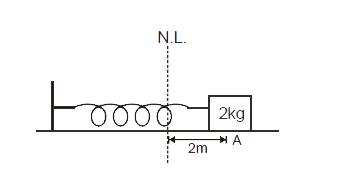An engine is attahed to a wagon through a shock absorber of length 1.5m. The system with a total mass of 50,000kg is moving with a speed of 36kmh−1 when the brakes are applied to bring it to rest. In the process of the system being brought to rest, the spring of the shock absorber gets compressed by 1.0m. If 90% of energy of the wagon is lost due to friction, calculate the spring constant.
Here,l=1.5m,m=50000kg=5×104kg
υ=36kmh−1=36×100060×60ms−1=10ms−1,x=1.0m,k=?
Total KE=12mυ2=12×5×104(10)2=2.5×106J
As 90% of energy of wagon is lost due to friction, therefore, energy transferred to shock absorber,
E=10100×2.5×106=2.5×105J
From E=12kx2
k=2Ex2=2×2.5×10512=5×105N/m
Topper's Solved these Questions
- BOOK - PRADEEPCHAPTER - WORK, ENERGY AND POWEREXERCISE - Long Answer Question24videos
WORK, ENERGY AND POWER
- BOOK - PRADEEPCHAPTER - WORK, ENERGY AND POWEREXERCISE - Advanced Problems For Competitions20videos
WORK, ENERGY AND POWER
- BOOK - PRADEEPCHAPTER - WORK, ENERGY AND POWEREXERCISE - Very Short Anwer Question.54videos
WORK, ENERGY AND POWER
- BOOK - PRADEEPCHAPTER - THERMODYNAMICSEXERCISE - Assertion- Reason Type Questions19videos
THERMODYNAMICS
Similar Questions
An engine is attached to a wagon through a shock absorber of length 1.5 m. The system with a total mass of 40,000 kg is moving with a speed of 72kmh1 when the brakes tare applied to bring it to rest. In the process of the system being brought to rest, the spring of the shock absorber gets compressed by 1.0 m. If 90% of energy of the wagon is lost due to friction, the spring constant is ________ ×105 N/m.
View SolutionAn engine is attached to a wagon through a shock absorber of length 1.5 m. The system with a total mass of 40,000 kg is moving with a speed of 72kmh1 when the brakes tare applied to bring it to rest. In the process of the system being brought to rest, the spring of the shock absorber gets compressed by 1.0 m. If 90% of energy of the wagon is lost due to friction, the spring constant is ________ ×105 N/m.
View Solution
Knowledge Check
- Question 1 - Select One
A railway engine (mass 104 kg) is moving with a speed of 72 km/h. The force which should be applied to bring it to rest over a distance of 20m is
A7200NB1000NC3600ND100000N - Question 2 - Select One
A motorcycle is being driven at a speed of 20 m/s when brakes are applied to bring it to rest in five seconds. The deacceleration produced in this case will be :
A+4m/s2B−4m/s2C+0.25m/s2D−0.25m/s2 - Question 3 - Select One
A block of mass 0.50kg is moving with a speed of 2.00m/s on a smooth surface. It strikes another mass of 1kg at rest and they move as a single body. The energy loss during the collision is
A0.16JB1.00JC0.67JD0.34J
A car having a mass of 1000 kg is moving at a speed of 30metres/sec. Brakes are applied to bring the car to rest. If the frictional force between the tyres and the road surface is 5000 newtons, the car will come to rest in
View SolutionA car was movig at a rate of 18kmh−1 . When the brakes were applied, it comes to rest in a distance of 100 m. Calculate the retardation produced by the brakes.
View SolutionA car of mass 500kg moving with a speed 36kmh in a straight road unidirectionally doubles its speed in 1min. Find the power delivered by the engine.
View SolutionThe block shown in figure is released from rest. Find out the speed of the block when the spring is compressed by 1 m
 View Solution
View SolutionA block of mass 1kg moving with a speed of 4ms−1, collides with another block of mass 2kg which is at rest. The lighter block comes to rest after collision. The loss in KE of the system is
View Solution

